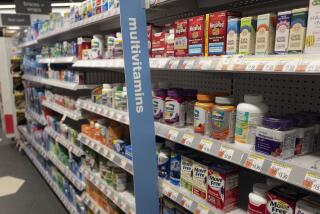Alluring but risky medicine
- Share via
In an early comedy routine, George Carlin compared football and baseball: “Baseball is a 19th century pastoral game,” he said. “Football is a 20th century technological struggle.... Football has hitting ... and unnecessary roughness and personal fouls. Baseball has the sacrifice.” In football, the quarterback riddles the defense with the shotgun; “in baseball, the object is to go home! And to be safe!”
Some might say the same can be said for conventional and alternative remedies. Conventional medicine has chemotherapy; alternative medicine has aromatherapy. Conventional drugs are synthetic and toxic; alternative remedies are natural and rid the body of toxins. Surgeons make large incisions under general anesthesia; acupuncturists balance yin and yang allowing chi, life’s vital energy, to flow. Orthopedists operate; chiropractors adjust.
Alternative medicine sounds like a chance to renew and refresh, to run through green meadows, breathe fresh air and bask in the sunshine. Conventional medicine sounds like a descent into the lower reaches of hell. “Baseball begins in the spring,” said Carlin, “the season of new life. Football begins in the fall, when everything is dying.”
It’s easy to be seduced.
But alternative medicine shouldn’t be given a free pass. Just because something sounds harmless doesn’t mean that it is harmless. If we are to take our healthcare seriously, we should insist that alternative products -- many of which are made by large pharmaceutical companies -- be held to the same standards of safety and effectiveness as any licensed product.
Unfortunately, because of the 1994 Dietary Supplement and Health Education Act, dietary supplements are not regulated by the Food and Drug Administration, so companies are under little obligation to support their claims or admit their harms.
For example, blue cohosh can cause heart failure; nutmeg can cause hallucinations; comfrey, kava, chaparral and valerian can cause inflammation of the liver; monkshood and plantain can cause heart arrhythmia; wormwood can cause seizures; stevia leaves can decrease fertility; concentrated green tea extracts can damage the liver; milkweed seed oil and bitter orange can cause heart damage; thujone can cause neurological damage; and concentrated garlic can cause bleeding.
In 1992, one of the worst dietary supplement disasters in history occurred when about 100 people developed kidney failure from a “slimming” mixture that contained the plant Aristolochia. At least 70 people required kidney transplants or dialysis; many later developed bladder cancers.
In 2008, more than 200 people -- including a 4-year old -- were poisoned by massive doses of selenium contained in the weight-loss products Total Body Formula and Total Body Mega. The products were supposed to contain 200 micrograms of selenium per serving; instead, they contained 40,800 micrograms.
Herbal remedies can also pose a danger. Two infants developed serious liver and nervous system injuries from a tea containing pennyroyal, and one died. Another infant died from a decongestant containing capsaicin. Sadly, only 170 (0.3%) of the 54,000 dietary supplements on the market have documented safety tests.
Further, dietary supplement labels aren’t all-inclusive. In 2004, researchers at Harvard Medical School tested Indian (ayurvedic) remedies obtained from shops within 20 miles of Boston’s City Hall. They found that 20% contained potentially harmful levels of lead, mercury and arsenic.
Between 1978 and 2004, herbal medicines caused 55 cases of severe or fatal heavy metal poisoning in the United States. In 2009, Kirkman Labs, a supplement manufacturer popular among parents of children with autism, recalled 15,000 bottles of zinc and other products because they contained undeclared antimony, a heavy metal. Herbal remedies have been found spiked with dexamethasone (a powerful steroid) and sildenafil (the active ingredient in Viagra).
These problems aren’t rare. Between 1983 and 2004, poison control centers in the United States received 1.3 million reports of adverse reactions to vitamins, minerals and dietary supplements, of which 175,268 required treatment in hospitals and 139 resulted in death.
In the end, any therapy that has a positive effect can have a negative effect. Alternative remedies are no different, even though words such as comfrey, valerian and chaparral sound disarmingly like something to revive a sleeping princess.






